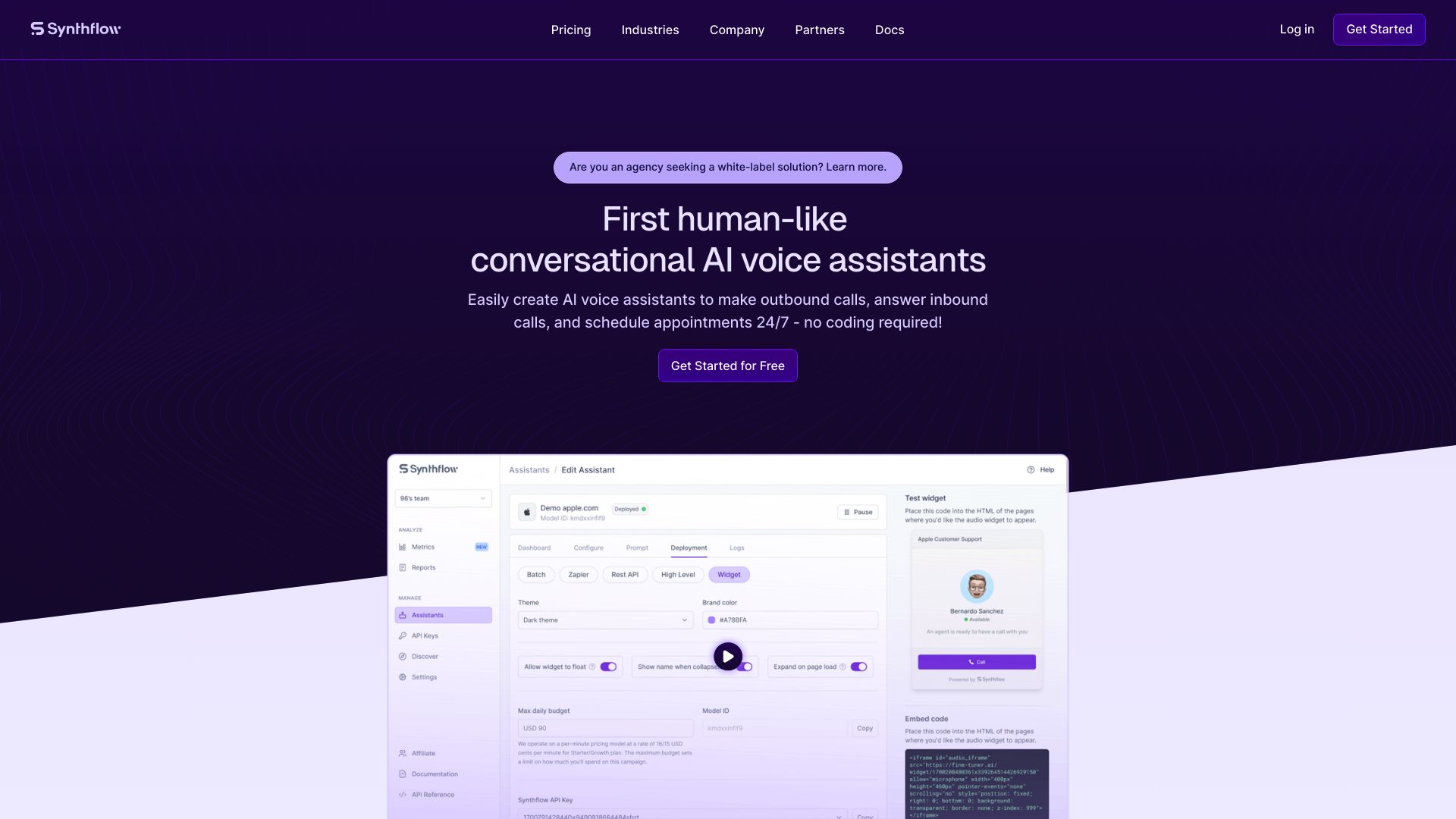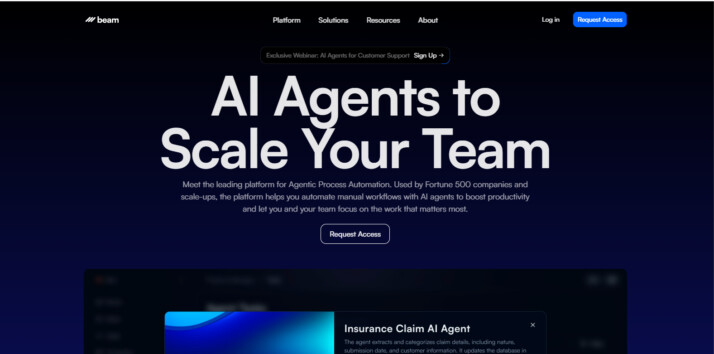Synthflow vs. Beam AI: Comparing AI Automation Platforms
AI-powered automation tools are transforming business operations, customer engagement, and productivity across industries. SmythOS, Synthflow vs. Beam AI represent cutting-edge platforms in this evolving landscape, each offering unique approaches to AI agent development and deployment. This comparison explores their key features, strengths, and limitations to help developers, business leaders, and AI enthusiasts make informed decisions. We’ll examine how these platforms tackle challenges in creating customizable AI assistants, process automation, and integration with existing systems. Whether you’re looking to streamline customer support, automate back-office tasks, or develop sophisticated AI agents, understanding the capabilities of these platforms is crucial for leveraging AI’s full potential in your organization.
Synthflow Overview
Synthflow empowers businesses to create customizable AI voice assistants without coding expertise. The platform’s no-code interface and pre-built templates make advanced AI technology accessible to users with varying technical backgrounds.


Synthflow’s AI assistants excel in customer support, lead generation, appointment scheduling, and issue triaging. The platform prioritizes data security, offering unlimited secure storage in a dedicated Pinecone environment. Integration capabilities with tools like 11Labs and Twilio expand its functionality, allowing seamless connection with existing business systems.
Synthflow empowers businesses to create customizable AI voice assistants without coding expertise. The platform’s no-code interface and pre-built templates make advanced AI technology accessible to users with varying technical backgrounds.
Key features include a visual builder for creating AI agents, support for both development and production environments, and the ability to maintain context within conversations. Synthflow enables autonomous agent operation, allowing AI assistants to perform tasks without human intervention. The platform also provides debug tools, audit logs, and analytics for performance monitoring and improvement.
While Synthflow excels in voice AI, it lacks explicit support for multimodal interactions. The platform doesn’t offer foundation AI models or direct integration with Huggingface AIs. However, it compensates with robust API support, including Zapier integration, enabling connections to thousands of applications.
Synthflow’s vision centers on democratizing AI technology, aiming to streamline operations and enhance customer engagement across various industries. By providing a user-friendly platform for creating sophisticated AI assistants, Synthflow positions itself as a valuable tool for businesses seeking to leverage AI without extensive technical resources.
Beam AI Overview
Beam AI revolutionizes task automation with its Agentic Process Automation (APA) technology. This AI-driven platform empowers organizations to streamline repetitive workflows, boosting productivity across various business functions. Beam’s autonomous agents excel in data processing, customer inquiry management, and regulatory compliance tasks, continuously learning to enhance their efficiency and accuracy over time.
Beam AI revolutionizes task automation with its Agentic Process Automation (APA) technology. This AI-driven platform empowers organizations to streamline repetitive workflows, boosting productivity across various business functions.
The platform’s core strengths lie in its versatility and adaptability. Beam AI caters to diverse industries, offering tailored solutions for back-office operations, customer service, and order processing. By leveraging advanced AI algorithms, these agents can interpret complex requests, maintain context throughout interactions, and execute multi-step processes with minimal human intervention.
Beam AI prioritizes sustainability and speed in its design philosophy. The platform aims to minimize unnecessary steps in workflows, reducing both time and resource consumption. This approach not only accelerates task completion but also aligns with eco-friendly business practices, appealing to organizations focused on efficiency and environmental responsibility.


While Beam AI offers robust automation capabilities, it may present a learning curve for users unfamiliar with AI technologies. The platform’s focus on voice AI assistants could limit its applicability in scenarios requiring multimodal interactions. Additionally, the absence of foundation AI models or direct integration with Huggingface AIs might restrict some advanced customization options for highly technical users.
Beam AI’s vision extends beyond current AI capabilities, aiming to pave the way for artificial general intelligence (AGI). This forward-thinking approach positions the platform at the cutting edge of AI development, promising continued innovation and expansion of its feature set. For businesses seeking to harness the power of AI for process optimization and customer engagement, Beam AI represents a compelling option in the evolving landscape of intelligent automation tools.
Feature Comparison
SmythOS and Beam AI offer distinct approaches to AI agent development, with notable differences in their core components and security features. SmythOS provides a comprehensive suite of tools for creating and deploying AI agents, including a visual builder, no-code editor, and support for multimodal interactions. These features enable users of varying technical backgrounds to develop sophisticated AI solutions. In contrast, Beam AI focuses on Agentic Process Automation (APA) technology, specializing in automating repetitive workflows across different business functions.
One significant gap lies in the platforms’ approaches to AI model integration. SmythOS supports a variety of foundation AI models and offers integration with Hugging Face, providing users with access to a wide range of pre-trained models. Beam AI, however, does not explicitly mention support for foundation models or Hugging Face integration, potentially limiting the flexibility in model selection and customization for advanced users.
In terms of security, both platforms prioritize data protection, but their implementations differ. SmythOS offers features like constrained alignment, data encryption, and OAuth integration, providing a robust security framework for enterprise-level deployments. Beam AI emphasizes sustainability and efficiency in its design, but specific details about its security measures are less prominent in the available information. This gap in security feature documentation could be a consideration for organizations with stringent data protection requirements.
Feature Comparison Table
| Synthflow | Beam AI | SmythOS | |
|---|---|---|---|
| CORE FEATURES | |||
| Visual Builder | ✅ | ❌ | ✅ |
| No-Code Options | ✅ | ❌ | ✅ |
| Debug Tools | ✅ | ❌ | ✅ |
| Multimodal | ❌ | ❌ | ✅ |
| SECURITY | |||
| IP Control | ❌ | ✅ | ✅ |
| COMPONENTS | |||
| Huggingface AIs | ❌ | ✅ | ✅ |
| Classifiers | ❌ | ✅ | ✅ |
| Data Lakes | ❌ | ❌ | ✅ |
| DEPLOYMENT OPTIONS (EMBODIMENTS) | |||
| Staging Domains | ❌ | ✅ | ✅ |
| Production Domains | ❌ | ✅ | ✅ |
| DATA LAKE SUPPORT | |||
| Hosted Vector Database | ✅ | ❌ | ✅ |
| Sitemap Crawler | ✅ | ❌ | ✅ |
| YouTube Transcript Crawler | ✅ | ❌ | ✅ |
| URL Crawler | ❌ | ❌ | ✅ |
| PDF Support | ❌ | ✅ | ✅ |
| Word File Support | ❌ | ✅ | ✅ |
| TXT File Support | ❌ | ✅ | ✅ |
Best Alternative to Synthflow and Beam AI
SmythOS stands out as the superior alternative to Synthflow and Beam AI for organizations seeking a comprehensive AI agent development platform. Our solution combines powerful features with unparalleled ease of use, making it the ideal choice for businesses of all sizes.
We offer a visual builder and no-code options that democratize AI development, allowing users with varying technical expertise to create sophisticated agents. Unlike Synthflow and Beam AI, SmythOS supports multimodal interactions, enabling the development of versatile agents capable of processing various data types, including text, images, and more.
SmythOS stands out as the superior alternative to Synthflow and Beam AI for organizations seeking a comprehensive AI agent development platform.
Our platform excels in providing a wide range of deployment options. Users can deploy AI agents as APIs, webhooks, site chats, or scheduled tasks, offering flexibility that surpasses both Synthflow and Beam AI. This versatility ensures that SmythOS can adapt to diverse business needs and use cases across industries.
Security is a top priority for SmythOS. We implement robust measures such as constrained alignment, data encryption, and OAuth integration, providing a level of protection that outperforms our competitors. This comprehensive security approach makes SmythOS the preferred choice for enterprises with stringent data protection requirements.
SmythOS distinguishes itself through its extensive integration capabilities. We support a variety of foundation AI models and offer seamless integration with Hugging Face, granting users access to a vast array of pre-trained models. This feature set empowers developers to create highly customized and powerful AI solutions, surpassing the limitations of both Synthflow and Beam AI.
Conclusion
Synthflow, Beam AI, and SmythOS each bring unique strengths to the AI automation landscape. Synthflow excels in creating voice AI assistants without coding, while Beam AI focuses on Agentic Process Automation for streamlining workflows. However, SmythOS stands out with its comprehensive approach to AI agent development and deployment.
SmythOS offers unparalleled flexibility and power. Our visual builder and no-code editor democratize AI creation, allowing users of all technical backgrounds to build sophisticated agents. Unlike Synthflow’s focus on voice or Beam AI’s emphasis on process automation, we support multimodal interactions and a wide range of AI models, including integration with Hugging Face.
Our platform’s robust security features, including data encryption and OAuth integration, provide enterprise-grade protection. This surpasses the explicitly stated security measures of both Synthflow and Beam AI. SmythOS also offers unique capabilities like constrained alignment and IP control, ensuring your AI agents operate within defined parameters.
For businesses and developers seeking to harness the full potential of AI, SmythOS provides the most comprehensive solution. Our ’create once, deploy anywhere’ philosophy, coupled with support for over 300,000 integrations, empowers you to build AI agents that seamlessly fit into your existing workflows. Explore our diverse range of AI-powered agent templates to jumpstart your journey into the future of AI automation. Get started with SmythOS today and experience the next generation of AI development and deployment.
Last updated:
Disclaimer: The information presented in this article is for general informational purposes only and is provided as is. While we strive to keep the content up-to-date and accurate, we make no representations or warranties of any kind, express or implied, about the completeness, accuracy, reliability, suitability, or availability of the information contained in this article.
Any reliance you place on such information is strictly at your own risk. We reserve the right to make additions, deletions, or modifications to the contents of this article at any time without prior notice.
In no event will we be liable for any loss or damage including without limitation, indirect or consequential loss or damage, or any loss or damage whatsoever arising from loss of data, profits, or any other loss not specified herein arising out of, or in connection with, the use of this article.
Despite our best efforts, this article may contain oversights, errors, or omissions. If you notice any inaccuracies or have concerns about the content, please report them through our content feedback form. Your input helps us maintain the quality and reliability of our information.
